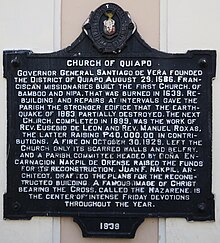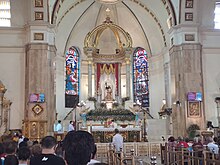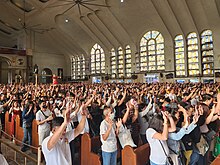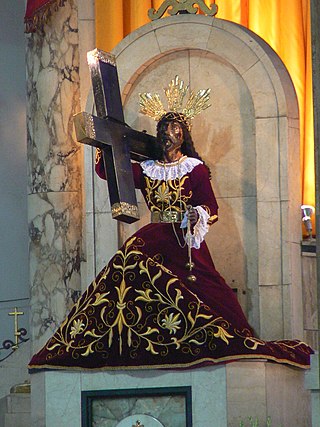
The Black Nazarene is a life-sized dark statue of Jesus Christ carrying the True Cross. The venerated image is enshrined in the Minor Basilica and National Shrine of the Black Nazarene in Quiapo, Manila, Philippines.

Our Lady of China, the Great Mother, also known as Our Lady of Donglü, is a Roman Catholic title of the Blessed Virgin Mary associated with a reputed Marian apparition in Donglü, China in 1900.

The Minor Basilica of San Sebastian and Archdiocesan Shrine of Our Lady of Mount Carmel, better known as San Sebastian Church or San Sebastian Basilica, is a minor basilica of the Roman Catholic Church in Manila, Philippines.

Santa Cruz is a district in the northern part of the City of Manila, Philippines, located on the right bank of the Pasig River near its mouth, bordered by the districts of Tondo, Binondo, Quiapo, and Sampaloc, as well as the areas of Grace Park and Barrio San Jose in Caloocan and the district of La Loma in Quezon City. The district belongs to the 3rd congressional district of Manila.
Rev. Msgr. Jose C. Abriol was a Filipino Catholic priest, linguist, and high official in the church in the Philippines. He was the first to translate the Catholic Bible into Tagalog, the native language for most Filipinos.

Holy Week is a significant religious observance in the Philippines for the Catholic majority, the Iglesia Filipina Independiente or the Philippine Independent Church, and most Protestant groups. One of the few majority Christian countries in Asia, Catholics make up 78.8 percent of the country's population, and the Church is one of the country's dominant sociopolitical forces.

The Feast of the Black Nazarene, also known as the Traslación after the mass procession associated with the feast, is a religious festival held in Manila, Philippines that is centered around the Black Nazarene, an image of Jesus Christ. It is celebrated annually on January 9.

Our Lady of Peñafrancia is an image of the Blessed Virgin Mary in the Philippines. The Marian image is permanently enshrined in the Minor Basilica of Our Lady of Peñafrancia in Naga, Camarines Sur.

Our Lady of Peace and Good Voyage, also known as Our Lady of Antipolo and the Virgin of Antipolo, is a seventeenth-century Roman Catholic wooden image of the Blessed Virgin Mary as venerated in the Philippines. This Black Madonna is enshrined in Antipolo Cathedral in the Sierra Madre mountains east of Metro Manila.

The Basilica Minore of Our Lady of Piat is one of the twenty-one minor basilicas in the Philippines. Located at Poblacion, Piat, in the province of Cagayan, it is the seat of the Roman Catholic Archdiocese of Tuguegarao. The shrine is dubbed as the Pilgrimage Center of Northeast Luzon and is home to the centuries-old brown Madonna Our Lady of Piat.

The Minor Basilica and Parish of the Immaculate Conception, alternatively known as the Archdiocesan Shrine of Santo Niño de Batangan, is a minor basilica in Batangas City, Philippines. It was made an independent parish in 1614 under the advocation of the Immaculate Conception. It is one of the oldest churches in Batangas.

The Our Lady of the Pillar Parish Church, commonly known as the Santa Cruz Parish Church and also designated as the Archdiocesan Shrine of the Blessed Sacrament, is a Mission Revival Roman Catholic parish church in the district of Santa Cruz, Manila, Philippines. It was built when the arrabal (suburb) of Santa Cruz was established by the Jesuits in the early 17th century. The church had undergone many repairs and reconstruction, with the last reconstruction done in the 1950s.
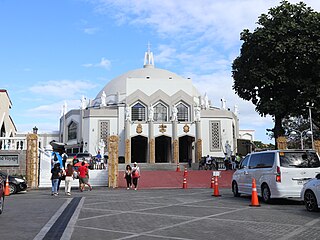
The International Shrine of Our Lady of Peace and Good Voyage, popularly known as the Antipolo Cathedral and alternatively known as the Immaculate Conception Parish, is a Roman Catholic cathedral in Antipolo, Philippines. It enshrines a venerated Black Madonna image of the Blessed Virgin Mary under the title of Our Lady of Peace and Good Voyage, and serves as the seat of the Bishop of Antipolo.

The National Shrine of Saint Jude Thaddeus or Saint Jude Parish is one of three Chinese parishes established by the Roman Catholic Archdiocese of Manila in Metro Manila, Philippines.
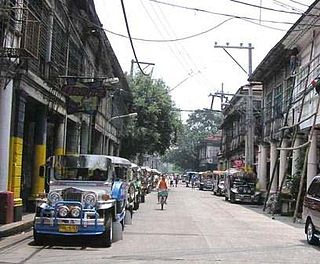
Hidalgo Street is a street located in Quiapo in the old downtown of Manila, Philippines. It runs east–west through the center of the district linking two of the district's most popular landmarks, Quiapo Church and San Sebastian Church. It is divided by Quezon Boulevard into two sections: the western section is a pedestrian zone that forms the southern boundary of Plaza Miranda running parallel to Carriedo Street, while the eastern section is a two-lane street which leads to the San Sebastian Church. Formerly known during the Spanish colonial times in sections as Calle [de] San Sebastian and Calle Crespo, respectively, it was renamed after the Filipino painter Félix Resurrección Hidalgo. It was once considered “the most beautiful street in Manila.”

The MacArthur Bridge is a road bridge crossing the Pasig River between Padre Burgos Avenue in Ermita and the intersection of Plaza Santa Cruz Road, Carriedo Street, Palanca Street, and Escolta Street in Santa Cruz. It replaced the Santa Cruz Bridge, which was destroyed during World War II. The bridge is named after General Douglas MacArthur, whose military operations led to the liberation of the Philippines during World War II.
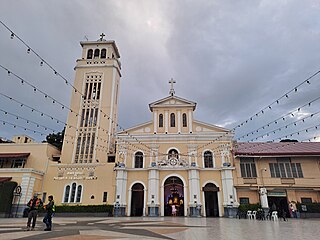
The Minor Basilica of Our Lady of the Rosary of Manaoag, commonly known as Manaoag Church, is a Roman Catholic minor basilica located in Manaoag, Pangasinan in the Philippines.

The Parish and National Shrine of Saint Padre Pio, commonly known as Padre Pio Shrine, is a Roman Catholic parish church and pilgrimage site situated along Governor Antonio Carpio Avenue in Barangay San Pedro, Santo Tomas, Batangas, Philippines. It is consecrated to the Italian Saint Pio of Pietrelcina.

The San Jose de Trozo Parish Church is a Catholic church in Santa Cruz, Manila in the Philippines. The current parish priest is Peterson O. Tieng. Founded in 1933, the church is under the jurisdiction of the Archdiocese of Manila.

The Minor Basilica of San Nicolas de Tolentino, also known as the Shrine of Santo Cristo Milagroso is a Roman Catholic church in the municipality of Sinait, Ilocos Sur, in northern Philippines. The church is known for housing the El Santo Cristo Milagroso, a life-sized dark-skinned image of crucified Christ. It is dedicated to Saint Nicholas of Tolentino and is under the administration of the Archdiocese of Nueva Segovia. In May 2021, it was announced that it was granted the title of minor basilica, the 19th in the Philippines and the first in its archdiocese.



